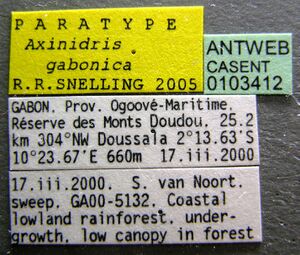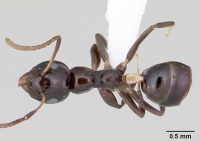Axinidris gabonica
| Axinidris gabonica | |
|---|---|

| |
| Scientific classification | |
| Kingdom: | Animalia |
| Phylum: | Arthropoda |
| Class: | Insecta |
| Order: | Hymenoptera |
| Family: | Formicidae |
| Subfamily: | Dolichoderinae |
| Genus: | Axinidris |
| Species: | A. gabonica |
| Binomial name | |
| Axinidris gabonica Snelling, R.R., 2007 | |
A forest dwelling species that is little known and poorly collected.
Identification
Snelling (2007) - Antennal scape with sparse short erect hairs; upper frons and pronotum each with two long erect hairs; gastral terga 3-4 each with one pair of long erect hairs; propodeal spines short and thick; head and body mostly shiny.
This species will run to Axinidris murielae in the key by Shattuck (1991), but is immediately separable by the scarcity of erect hairs on the vertex and frons. The general habitus is similar, but Axinidris gabonica is darker, and in both species the punctures of the frons and pronotum are relatively coarse.
Keys including this Species
Distribution
Latitudinal Distribution Pattern
Latitudinal Range: -2.234166667° to -2.30921°.
| North Temperate |
North Subtropical |
Tropical | South Subtropical |
South Temperate |
- Source: AntMaps
Distribution based on Regional Taxon Lists
Afrotropical Region: Gabon (type locality).
Distribution based on AntMaps
Distribution based on AntWeb specimens
Check data from AntWeb
Countries Occupied
| Number of countries occupied by this species based on AntWiki Regional Taxon Lists. In general, fewer countries occupied indicates a narrower range, while more countries indicates a more widespread species. |

|
Estimated Abundance
| Relative abundance based on number of AntMaps records per species (this species within the purple bar). Fewer records (to the left) indicates a less abundant/encountered species while more records (to the right) indicates more abundant/encountered species. |

|
Biology
Species of Axinidris appear to nest exclusively within hollow plant stems, both living and dead, and in rotten wood. They are found in forested areas throughout the Afrotropical region, but are most abundant and diverse in the moist equatorial forests. Workers are primarily arboreal foragers, but may occasionally forage in ground litter.
Castes
In Snelling's description (2007) he states the queens and males of Asinidris gabonica are unknown. One of his paratypes is a queen - and is presently undescribed.
Worker
Images from AntWeb
   
| |
| Paratype of Axinidris gabonica. Worker. Specimen code casent0003125. Photographer April Nobile, uploaded by California Academy of Sciences. | Owned by CAS, San Francisco, CA, USA. |
   
| |
| Paratype of Axinidris gabonica. Queen (alate/dealate). Specimen code casent0103412. Photographer April Nobile, uploaded by California Academy of Sciences. | Owned by CAS, San Francisco, CA, USA. |
Nomenclature
The following information is derived from Barry Bolton's Online Catalogue of the Ants of the World.
- gabonica. Axinidris gabonica Snelling, R.R. 2007: 559, figs. 3, 13, 23 (w.) GABON.
- Type-material: holotype worker, 4 paratype workers.
- Type-locality: holotype Gabon: Prov. Ogoové-Maritime, Réserve des Monts Doudou, 25.2 km. 304° NW Doussala (2°13.63’S, 10°23.67’E), 660 m., 17.iii.2000 (S. van Noort); paratypes: 2 workers with same data, 2 workers with same data but 16.iii.2000.
- Type-depositories: CASC (holotype); CASC, LACM (paratypes).
- Distribution: Gabon
Unless otherwise noted the text for the remainder of this section is reported from the publication that includes the original description.
Description
Worker
Worker measurements (mm) (n = 3). HW 0.77-0.83; HL 0.83-0.90; SL 0.72; EL 0.21-0.22; OVD 0.28-0.30; PNW 0.50-0.56; PPW 0.36-0.40; WL 1.01-1.10. Indices. CI 91-94; CNI 117-140; OI 25-26; SI 86-93.
Head shiny, frons weakly coriarious between sparse distinct punctures, more strongly sculptured on frontal area; gena and malar area shinier and almost smooth. Antennal scape shafts with a few widely spaces fine erect hairs; frons, below vertex, with 1 pair of long erect hairs and a shorter pair near upper end of frontal carinae and a still shorter pair at lower end of carinae; clypeus with about 6 long erect hairs.
Pronotum shiny and nearly smooth between distinct sparse punctures and with a single long erect hair near each humerus. Mesonotum similar to pronotum, but narrowly contiguously punctate posteriorly. Metanotal spiracles elevated but appressed to base of propodeum, not conspicuous in profile. Mesepisternum largely smooth and shiny anteriorly, becoming duller and contiguously punctate posteriorly. Propodeum slightly shiny, contiguously to subcontiguously punctate; spiracular prominence weak and spiracular opening directed distad; medial carina present on posterior half of dorsal face, absent from declivitous face, slightly elevated at summit of declivity and low and broadly rounded in profile; propodeal spines short and blunt, obtuse in dorsal view with straight outer margins, distance between outer margins of apices distinctly less than distance between spiracles.
Gastral terga shiny, smooth to weakly coriarious; T3-T4 each with a single long erect hair on each side; appressed pubescence sparse. Head blackish, body dark brown; distal portion of mandible yellowish, with reddish yellow teeth; legs brown, distitarsi yellowish; petiole mostly whitish.
Type Material
Holotype worker, GABON, Prov. Ogoové-Maritime, Réserve des Mons Doudou, 25.2 km 304° NW Doussala (2°13.63'S 10°23.67'E), 660m, 17 March 2000 (S. van Noort), sweeping in coastal lowland rainforest. Paratypes: 2 workers, same data as holotype, 2 workers, same except 16 March 2000. Holotype and 2 paratypes in California Academy of Sciences; 1 paratype in Los Angeles County Museum of Natural History.
Etymology
The name is derived from that of the country of origin.
References
References based on Global Ant Biodiversity Informatics
- Snelling, R. R. 2007. A review of the arboreal Afrotropical ant genus Axinidris, pp. 551-579. In Snelling, R. R., B. L. Fisher, and P. S. Ward (eds). Advances in ant systematics (Hymenoptera: Formicidae): homage to E. O. Wilson 50 years of contributions. Memoirs of the American Entomological Institute, 80.

